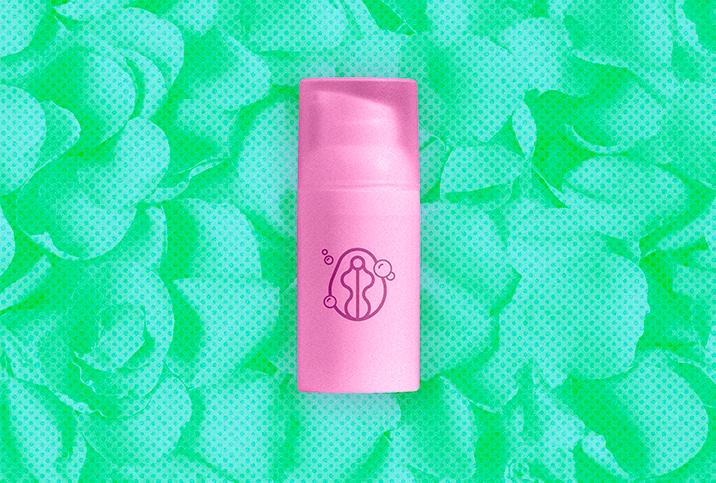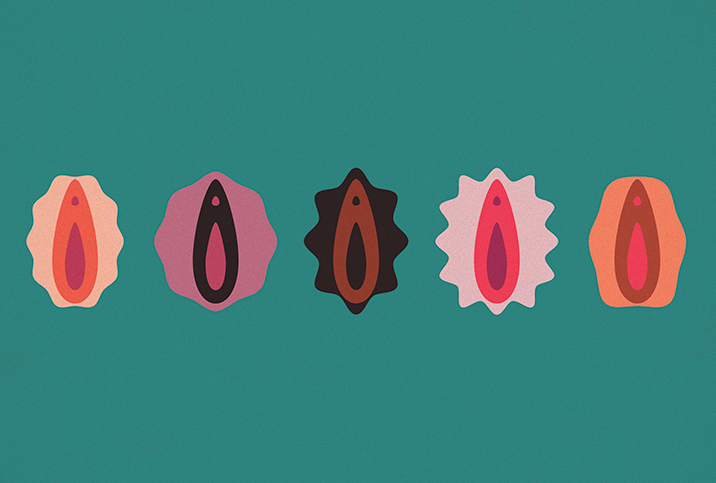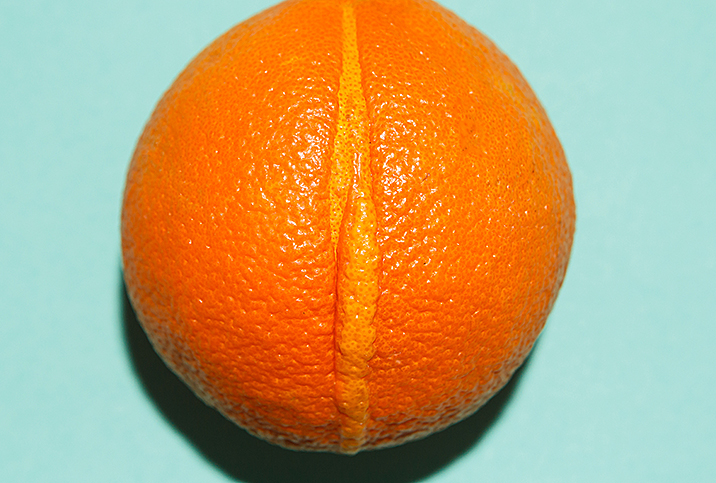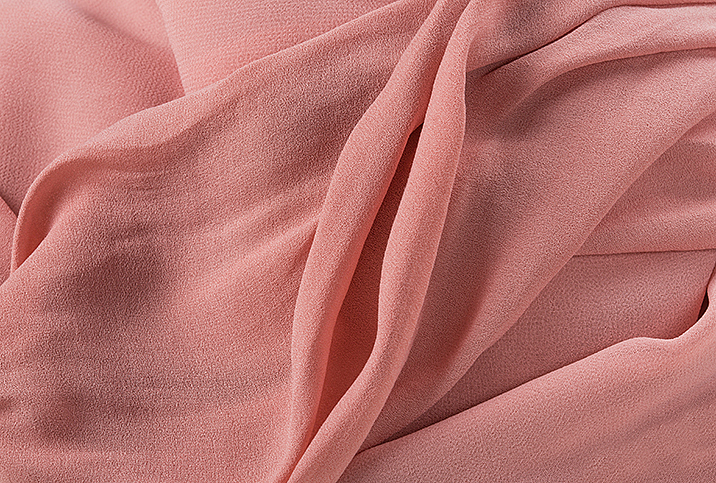What Is the Positivity Movement Around Different Vulvas?

Let me introduce you to the vulva. Also known as "p---y lips," "pudenda," "punani," "concha," "private parts" and many more colorful names.
The vulva is the external portion of female genitalia—including the labia majora, labia minora and clitoris—and comes in as many shapes, colors and sizes as there are names for the body part.
Unfortunately, societal shame and a general lack of education surrounding the topic has led to a spike in anxiety regarding what you're supposed to look like "down there." One in 7 women have considered labiaplasty—plastic surgery to alter the appearance of the vulva—in their lifetime, and 87 percent of the cases are done purely for aesthetic concerns by the patient.
While labiaplasty is now the fastest-growing and 15th-most popular plastic surgery procedure, a countermovement has emerged in recent years celebrating the diversity and beauty of different vulvas.
From the Vagina Museum's labia exhibits, the phrase "phat coochie" trending on social media, illustrator Hilde Atalanta's book, "A Celebration of Vulva Diversity," and ethical porn company Afterglow's series of vulva diversity events, more and more resources are popping up to celebrate what Mother Nature gave us.
Why are people unhappy with their vulvas?
For Kecia Gaither, M.D., a board-certified OB-GYN in New York City who looks at various vulvas every day during childbirth and Pap smears, a healthy vulva is a beautiful vulva. As far as she's concerned, as long as your vulva serves its physical functions, there isn't a need for alteration. These functions include protecting the internal parts of the female reproductive tract, playing a role in sexual arousal and stimulation, and providing lubrication and cushioning.
"There is no standard, 'normal' vulva," she explained. "Every woman is different, and body parts reflect that difference."
Why is there such a concern about the vulva's appearance?
Mainstream porn may bear the brunt of the blame, but porn performers have a wide range of vulvas themselves. After all, the talent pool would be extremely limited if only one type of genitalia was preferred.
"I think porn has a lot more vulva diversity than people think it does," said Lilly Sparks, the founder of Afterglow, based in Austin, Texas.
However, Sparks acknowledged that most mainstream porn videos don't even feature vulvas and instead tend to focus more on phallocentric imagery emphasizing the penis, intercourse or ejaculation. Thus, women are likely to think their vulvas are not "normal" because they simply don't see a variety of vulvas up close on the screen.
The lack of representation of vulvas in their relaxed state may compound internalized anxieties, considering up to 73 percent of adult women don't even know what the vulva is and an Australian study from 2015 found 53 percent of adult women had never seen a real-life vulva other than their own.
"I remember when I was growing up, my friends watching porn and talking about how vulvas should look," Sparks said. "My friend was like, 'That looks like a poorly packed suitcase.' I was like, mine looks like that and I was embarrassed. The nice ones are supposed to be straight, even."
Another reason behind vulva insecurity and the rise in labiaplasty may be how we dress and how we portray what a vulva should look like. Ever-shrinking swimsuits, athleisure wear and photos posted on social media of women wearing tight clothes may make women more aware of pronounced bulges and flaps.
Miami-based, board-certified plastic surgeon Alexander Zuriarrain, M.D., specializes in labiaplasty and has surgically trimmed, cut and aesthetically altered more than 200 vulvas. Business is booming, too. He's seen a 50 percent increase in the past few years, which he partially attributes to increased awareness of the procedure on social media.
"The vast majority of patients desire both functional and cosmetic improvements of the genital region," he said. "There is definitely an association with the trend to wear tight, athletic clothing. In communities like Miami that are surrounded by the ocean, many women seek this procedure to avoid exposure to pronounced labia while wearing a bikini.
"Mainly, patients ask for a reduction of the excess labia minora. They want a tighter vaginal appearance with less excess labia. They rarely bring any photos," he added.
Zuriarrain said he enjoys his work.
"[It] is one of the best plastic surgery procedures regarding long-term confidence and satisfaction," he said. "They have sexual satisfaction, physical satisfaction when performing different activities and cosmetic satisfaction when wearing all different types of clothing."
He's not wrong. According to questionnaire results published in Plastic and Reconstructive Surgery journal, 93 percent of 166 women who had undergone labiaplasty reported improved self-esteem.
This finding further reinforces the chicken-or-the-egg question: How do we address the confidence crisis surrounding healthy body parts?
Celebrating different vulvas: A close-up
Sparks started Afterglow's "Vulva Love" event series to let all people with vulvas know their unique vulva is special. The series features different vulvas of all types in different situations, whether relaxed, being masturbated or being worshipped.
"When you're exposed to vulvas that look different, vulva confidence and body confidence improves," Sparks said.
The series plays video segments of different types of vulvas interspersed with commercial breaks of "Zen p---y meditation," where different close-ups of vulvas are "breathing" and orgasming on screen. Sparks explained that she hopes to create "porn you can learn from."
"We wanted to do something that is empowering to women. We try to show that porn is good for you," Sparks said.
"It's really about normalizing our bodies," she continued. "It's only recently that people have started using the accurate terms. We grow up with all this shame around our bodies and it makes us feel bad about what's down there. This movement is about getting rid of the shame we grew up with."
Secrecy, anxiety and fear of being "wrong" have long been unfortunate hallmarks of how we treat sex. Those anxieties are projected onto every part of our lives, starting from visceral body parts and how tidy we think they should be.
As playwright Eve Ensler famously said in 1996 as part of her episodic play, "The Vagina Monologues": "I was worried about my own vagina. It needed a context of other vaginas—a community, a culture of vaginas. There's so much darkness and secrecy surrounding them, like the Bermuda Triangle."
The vulva diversity movement is combating this shame by bringing it to the spotlight, and that starts with the appropriate terminology.


















